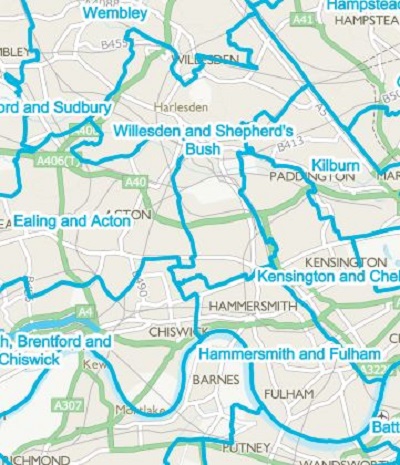Boundary Commission Confirms Controversial Plans for New Local Constituencies
Hammersmith and Fulham reunited but Shepherd's Bush wards added to Willesden
The Boundary Commission has retained controversial plans to reunite Hammersmith and Fulham as a parliamentary constituency, but without the four wards in Shepherd's Bush in its final recommendations for the 2018 Review of Parliamentary Constituency Boundaries.

The commission's original proposal envisaged splitting the four wards in Shepherd's Bush into two new constituencies, but in revised proposals published two years ago, it added them to a new constituency, to be called Willesden and Shepherd's Bush.
At the time, the commission noted that there would be opposition to this, but saw no other option.
In the south, the final proposals remain unchanged, envisaging scrapping the existing constituency of Chelsea and Fulham, created in the last Boundary Commision review in 2010. It has been one of the safest Tory seats in the country, with MP Greg Hands retaining his seat throughout.
Under the proposals the six wards in Fulham will join the six wards in Hammersmith to create the new constituency of Hammersmith and Fulham, thus scrapping the current Hammersmith constituency, again created in the 2010 review, where Labour MP Andy Slaughter has retained his seat throughout.

As this map of the proposals shows, this proposed constituency follows the same boundaries as the borough of Hammersmith and Fulham as far north as Goldhawk Road.
This means the new constituency contains the following wards: Addison, Avonmore and Brook Green, Fulham Broadway, Fulham Reach, Hammersmith Broadway, Munster, North End, Palace Riverside, Parsons Green and Walham, Ravenscourt Park, Sands End and Town.
The four wards north of this ward - Askew, College Park and Old Oak, Shepherd's Bush Green and Wormholt and White City - now join a new T shaped constituency called Willesden and Shepherd's Bush which also contains Brondesbury Park, Harlesden, Kensal Green, Mapesbury, Stonebridge and Willesden Green, all within the borough of Brent.
In its final report the commission admits the revised proposals did not meet with universal approval, saying: " Our Willesden and Shepherd’s Bush constituency was also opposed as respondents considered the areas did not share community ties with each other.
"As with our initial proposals, we received some opposition to our Hammersmith and Fulham constituency with counter-proposals again suggesting changes to neighbouring constituencies, including Kensington and Chelsea.
"We received a general level of support for many of our other revisions in this part of the sub-region."
And in its final recommendations, its says: " We noted that, during the consultation on the revised proposals, we again received a number of representations that opposed the Hammersmith and Fulham constituency.
"Similarly to previous consultations, the counter-proposals were for a Hammersmith and Shepherd’s Bush constituency, which resulted in consequential changes to neighbouring constituencies.
" We consider that no further compelling evidence has been received to modify the Hammersmith and Fulham constituency and so we confirm it as part of our final proposals."
If the new boundaries are approved by Parliament, the new boundaries will be in place for the next scheduled general election in 2022.
Sam Hartley, secretary to the Boundary Commission for England, said: "We've travelled the country, taken account of over 35,000 public comments, and heard many impassioned views about how best to reflect local communities in our recommendations, while ensuring that constituencies are all much more equally represented.
"We're confident that the map we propose today is the best match of the legal rules Parliament has set us. It's now up to Parliament to decide whether these boundaries will be used at the next general election."
September 11, 2018